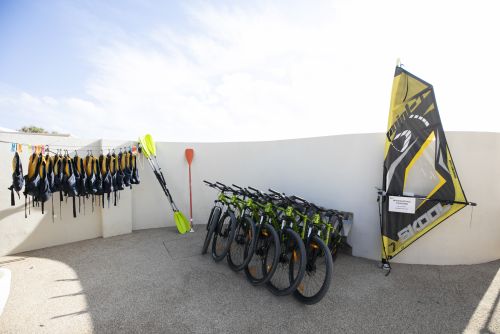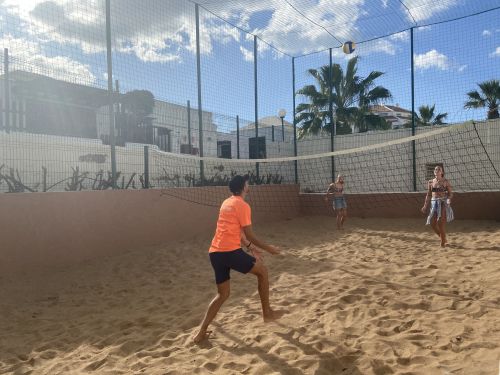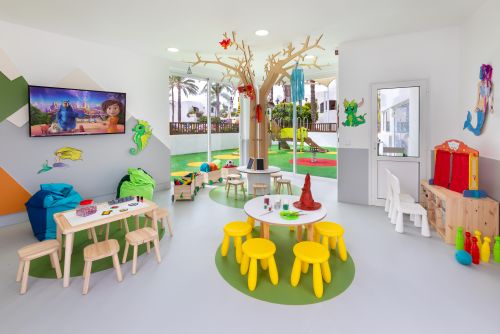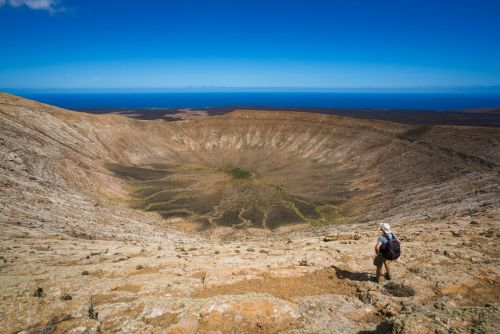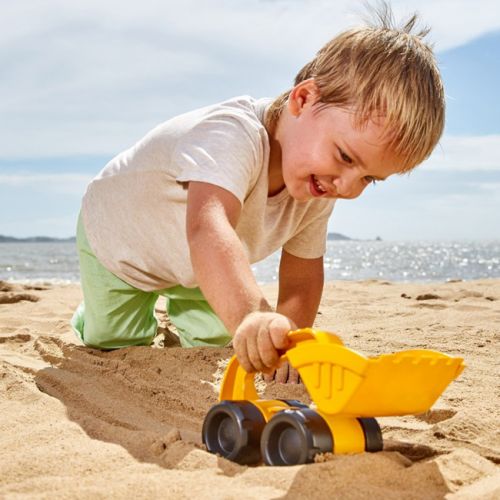Cycling in the Canary Islands is synonymous with riding along lonely roads on sunny days with almost no other vehicles, with the thrill of discovering new landscapes around every curve and chasing the sea on the horizon.
There are unforgettable experiences, especially if they are on a bicycle throughout the Canaries. In fact, the particular orography of the archipelago makes them perfect for road cycling.
In the Canary Islands cyclists enjoy asphalted roads and roads full of slopes and gradients, which run through volcanic passes and are a huge challenge for cyclists of all levels. Do you dare to cycle through the Fortunate Islands?

Best cycling routes in Gran Canaria

If you like cycle touring and direct contact with nature, you're in luck, because Gran Canaria has numerous routes for you to enjoy. Whether you prefer mountain biking or long-distance routes, two wheels are the ideal ally for discovering unspeakable landscapes.
Cycling enthusiasts have a multitude of routes to do all year round thanks to Gran Canaria's mild climate and discover first-hand why the island is known as the ‘miniature continent’. In fact, cycling in the Canary Islands has a name: Gran Canaria.
1. Cycling route through the north of Gran Canaria (83 km)

The first of the cycling routes through Gran Canaria takes us to the north of the island: Las Palmas de Gran Canaria-Los Pinos de Gáldar-Las Palmas de Gran Canaria.
We start in the capital, Las Palmas de Gran Canaria, where we join the GC-2 towards Bañaderos.
We take the GC-330, and continue to the village of Bañaderos. When we reach the petrol station, we turn right onto the GC-301 uphill towards Trapiche/Firgas.
We follow the GC-300 at a junction on the right towards Firgas/Moya, which takes us to Buenlugar.
We come to a junction on the left towards Firgas on the GC-302, enter this village and continue towards Valleseco/Teror.
At the next junction we take the GC-21 towards Valleseco and after about 100 metres we get to the Balcón de Zamora.
We continue towards Valleseco and after 200 metres we turn left at another junction onto the GC-21 in the direction of Artenara/Tejeda.
We keep on along the main road and after 43 kilometres we reach the top of Los Pinos de Gáldar.
We return on the GC-21 in the direction of Valleseco and after 700 metres we turn left onto the GC-70 towards Fontanales/Moya/Gáldar.
We turn right at a junction on the GC-70 towards Moya/Fontanales and continue downhill towards Fontanales/San Fernando.
At the junction we take the GC-75 in Moya and continue in the direction of Las Palmas de Gran Canaria. We join the GC-2 and return to the starting point.

2. Cycling route through the north of Gran Canaria (100 km)

Cycling in the Canary Islands continues with the second of the cycling routes through Gran Canaria, specifically in the south: Maspalomas-Mogán-Cruz de San Antonio-Ayacata-San Bartolomé de Tirajana-Maspalomas.
We start from Maspalomas and take the GC-500 in the direction of Mogán along the coast, leaving Arguineguín and Puerto Rico behind us.
At the junction with Puerto de Mogán we turn right and join the GC-200 for an 8 kilometre climb to the village of Mogán.
About 2.5 kilometres past the village we turn right towards Pie de la Cuesta and begin a pass of approximately 10 kilometres to the Cruz de San Antonio.
We turn left onto the GC-605 towards Ayacata and continue uphill with the Presa de las Niñas dam on the right, at which point we will have covered about 50 kilometres.
We continue along the GC-60 towards San Bartolomé de Tirajana and Fataga. We start the descent to Arteara, where we climb up to the Degollada de las Yeguas viewpoint.
Finally, we continue an easy descent of about 8 kilometres towards the starting point: Maspalomas.

3. Circular cycling route along the coast of Gran Canaria (190 km)

The third of the cycling routes around Gran Canaria takes us on an unforgettable route for all those who love cycling in the Canary Islands: cycling around the whole island.
The thing about this route is that you can start from any point along the coast of Gran Canaria, so it doesn't matter where you are.
You just have to bear in mind the roads to follow: the GC-1, the GC-500, the GC-200 and the GC-2.
Some of the towns we will pass through are: Puerto de Mogán, Mogán, La Aldea de San Nicolás, Agaete, Las Palmas de Gran Canaria, Carrizal de Ingenio, Cruce de Arinaga, Vecindario, Maspalomas or Arguineguín, among others.

Best cycling routes in Tenerife

Breathe in. Breathe out. A little harder. More pace. Come on! Focus on yourself, on your ride and on when to stop to contemplate a new spectacular landscape.
On this island you can cycle at sea level or at an altitude of over 2,000 metres. So it's no wonder that the best cyclists in the world choose Tenerife for their training.
Whether you are just a beginner or a professional, in Tenerife you have a wide range of routes and services to choose from that suit your needs.
1. Circular cycling route through the north-east of Tenerife (52 km)

Cycling in the Canary Islands cannot be understood without the first of the cycling routes through Tenerife, specifically through the northeast of the island: Santa Cruz de Tenerife-Pico del Inglés-Santa Cruz de Tenerife.
We start from the island's capital, Santa Cruz de Tenerife, and take the TF-11 parallel to the coast. We reach the fishing village of San Andrés and turn left onto the TF-12.
We start the ascent and after about 18 kilometres we reach a junction of the TF-12 with the TF-123. We continue straight on in the direction of Las Mercedes/La Laguna.
We pass the Abicor viewpoint in the middle of the Anaga Massif and after a flat area we descend to the caserío Casas de la Cumbre.
We start another ascent to the Pico del Inglés viewpoint and begin a long descent along the TF-12, passing the Cruz del Carmen and the Lomo Alto viewpoint.
At kilometre 36 we pass through Las Mercedes, continue along the TF-13 towards La Laguna and join the Camino de Las Mercedes (or Camino de Las Peras).
We enter La Laguna and continue descending until we reach the starting point: Santa Cruz de Tenerife.

2. Cycling route through the north of Tenerife (75 km)

The best of cycling in the Canary Islands continues with this easy cycling route through the north of Tenerife that takes us from Buenavista del Norte to Punta del Hidalgo.
We start in Buenavista del Norte, in the northwest corner of Tenerife and take the TF-42 heading east along the coast.
Along this road we pass through Los Silos, Garachico, Icod de los Vinos, San Juan de la Rambla, El Mirador, San Pedro and Los Realejos.
The road then becomes the TF-5 motorway, so to avoid it we turn left onto the TF-320 towards La Orotava.
We continue along the TF-21 passing the Humboldt viewpoint and join the TF-217 to La Matanza. We cross the TF-5 and join the TF-1224 to Las Breñas.
We continue along the Los Ángeles road towards El Sauzal until the roundabout at the El Pris crossroads and take the TF-16 towards Valle de Guerra and Tejina.
Finally, we join the TF-13 towards Bajamar and continue to the end of the route: Punta del Hidalgo.

3. Cycling route through the centre of Tenerife (162 km)

The great length and number of metres climbed on this cycling route through the centre of Tenerife make it one of the most difficult cycling routes in the Canary Islands.
Just look at the number of places it passes through: Costa Adeje-Trasera de Los Cristianos-Carretera General del Sur-Arafo-Dorsal de la Esperanza-Parque Nacional del Teide-Vilaflor-Arona-Trasera de los Cristianos-Costa Adeje.
We start in Costa Adeje by driving up the TF-5, where we turn right onto the TF-481 towards San Eugenio. After about 5 kilometres we turn left, cross the motorway again and take the TF-481 until we meet the TF-28.
We continue alongside La Camella and Valle San Lorenzo, passing the La Centinela viewpoint and reaching the villages of San Miguel and Charco del Pino.
We reach Granadilla and join the TF-28, passing through Arico, Fasnia, El Escobonal, the Don Martín viewpoint and Güímar, where we turn left onto the TF-525.
We continue towards Arafo, where the road becomes the TF-523 and climbs towards the Teide National Park. When we reach the junction with the TF-24, we turn left and continue climbing.
Along the way we pass the viewpoints of Ayosa, La Crucita and La Tarta. At kilometre 98 we reach the Izaña Astronomical Observatory.
We continue and turn left onto the TF-21 towards the Teide and Boca Tauce, just where there is a bar-restaurant and a Visitor Centre with very useful information.
We continue this cycling route in the Canary Islands along the TF-21 passing Montaña Blanca and the ascent point of the cable car to the Teide. We continue past the Parador de las Cañadas del Teide.
We join the TF-38 and descend towards Vilaflor and Granadilla. We pass the first village and take the TF-51 towards Las Américas and Arona.
We continue the descent on the TF-51 passing La Camella, where we turn right onto the TF-28 towards Las Américas and Los Cristianos.
At kilometre 157 we reach a junction with the TF-1, where we take the TF-481 towards Las Américas and arrive at the starting point: Costa Adeje.
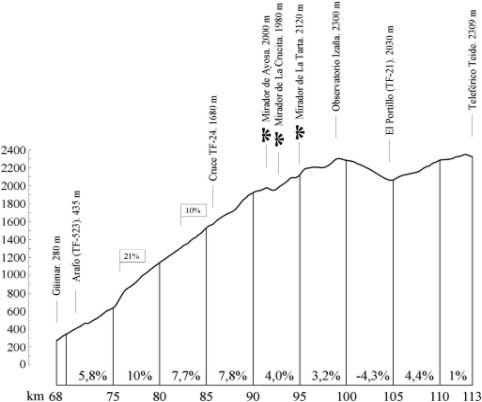
Best cycling routes in Lanzarote

Road cycling while enjoying the views that Lanzarote has to offer, passing through the Salinas de Janubio, the Montañas del Fuego, Caleta de Famara, La Geria or the Mirador del Río is an experience that won’t leave you indifferent. And no wonder.
All cycling lovers are in luck, because they can enjoy numerous routes on which they can cover kilometres through unique landscapes, thanks to the singularity and beauty of the island of volcanoes.
1. Circular cycling route through the south of Lanzarote (64 km)

Cycling in the Canary Islands takes us to its easternmost island: Lanzarote. The first cycling route will be through the south of the island: Puerto del Carmen-Conil-Yaiza-El Golfo-Playa Blanca-Femés-Puerto del Carmen.
We start in Puerto del Carmen and head towards the wine region of La Geria. We continue to the other side of the island, specifically to the volcanic crater El Golfo and the cliffs of the old road LZ-701 towards Playa Blanca and Femés, to return to the starting point.
2. Cycling route through the north of Lanzarote (105 km)

This circular cycling route through the north of the island crosses the towns of: Puerto del Carmen-Arrecife-Costa Teguise-Arrieta-Órzola-Haría-Arrieta-Teguise-Teguise-Tías-Puerto del Carmen.
This is a route of contrasts in which we start from Puerto del Carmen and continue along the coastline towards the north, passing through the capital of the island: Arrecife.
We continue towards the tourist resort of Costa Teguise and head inland and northeast towards the charming coastal village of Arrieta.
We then continue along the northern coast to the seaside enclave of Órzola. We head inland and drive around the enigmatic La Corona volcano to the town of Haría.
We continue in search of the beautiful inland landscapes of Lanzarote with this cycling route in the Canary Islands to the historic village of Teguise, from where we continue southwest to the town of Tías and finish at the starting point: Puerto del Carmen.
3. Ironman Lanzarote cycling route (180 km)

The demanding Ironman race is held in Lanzarote with a tough cycling route that all lovers of this sport can practice whenever they want.
The route passes through Puerto del Carmen-Yaiza-El Golfo-Timanfaya-La Santa-Caleta de Famara-Teguise-Haría-Mirador del Río-Arrieta-Tahíche-Teguise-La Geria-Puerto del Carmen.
Apart from its large distance (180 kilometres), the difficulty of this route lies, above all, in the enormous positive difference of 2,130 metres, a real challenge for the most experienced cyclists.
Cycling in the Canary Islands, a year-round sport
Keep in mind the following recommendations if you are going to do any of the above cycling routes:
- Take care of the environment.
- Attention to lights.
- Identification and documentation.
- Always carry water.
- Wear a helmet.
- Wear a coat if you go up to the mountains.
- Drive on the right.
- Emergency number: 112.
- Check weather forecasts before setting off.
- Be extremely cautious.
- When travelling alone, always tell someone by leaving a mobile phone number so that they know where you are.






































































